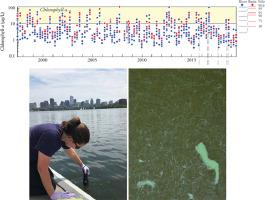Water Research ( IF 11.4 ) Pub Date : 2021-07-15 , DOI: 10.1016/j.watres.2021.117434 Rose T Determan 1 , Jeffrey D White 2 , Lawrence W McKenna 3

|
Despite massive financial investment in mitigation, eutrophication remains a major water quality problem and management priority. Eutrophication science—well established for lakes—is not as well developed for rivers, and scientific understanding of how rivers respond to eutrophication management is far more limited. Long-term data are required to evaluate progress, but such datasets are relatively rare for rivers. We analyzed 23 years of water quality data for the Charles River, a major urban river system in the northeastern U.S.A., to examine nutrient and phytoplankton biomass (chl-a) responses to decades of phosphorus (P) management. Using the more novel and robust approach of quantile regression, we identified statistically and ecologically significant declines in both total phosphorus (TP) and chl-a over time, but only for middle percentiles. Statistically high concentrations of TP and chl-a persist—the segments of the data of greatest concern to managers and the public—and yet this critical result is concealed by statistical tests often employed in eutrophication studies that only evaluate mean changes. TP, temperature, precipitation, and river segment jointly explain the most chl-a variation observed at the decadal scale. Spatial variation is also considerable: despite a significant decline in TP, the impounded lower river exhibits no long-term trend in chl-a and continues to experience annual blooms of harmful cyanobacteria—a lagging response comparable to that of a recovering eutrophic lake. Despite long-term successes in reducing P, chl-a, and cyanobacteria in the Charles River system, we did not detect any significant, long-term change in the attainment of statutory compliance, illustrating the protracted and complex nature of the river's response. Our analysis demonstrates the need for high-frequency, long-term water quality data to evaluate the progress of eutrophication management in urban rivers, and the utility of quantile regression for detecting critical trends in the occurrence of statistically low-frequency but ecologically high-impact events, including blooms of harmful cyanobacteria.
中文翻译:

分位数回归阐明了城市河流系统中长期富营养化修复工作的成功与不足
尽管在减缓方面进行了大量财政投资,但富营养化仍然是一个主要的水质问题和管理重点。富营养化科学——为湖泊建立了良好的基础——并没有为河流发展得那么好,对河流如何应对富营养化管理的科学理解要有限得多。评估进展需要长期数据,但河流的此类数据集相对较少。我们分析了美国东北部主要城市河流系统查尔斯河 23 年的水质数据,以检查营养物质和浮游植物生物量 (chl- a ) 对数十年磷 (P) 管理的响应。使用更新颖、更稳健的分位数回归方法,我们确定了总磷 (TP) 和氯的统计和生态显着下降。一个随着时间的推移,但仅限于中层百分点。TP 和 chl - a 的统计高浓度仍然存在——管理人员和公众最关心的数据部分——然而,这一关键结果被富营养化研究中经常使用的统计测试所掩盖,这些测试通常只评估平均变化。TP、温度、降水和河段共同解释了在年代际尺度上观察到的最大 chl- a变化。空间变化也相当大:尽管 TP 显着下降,但被蓄水的下游河流没有表现出长期的 chl- a趋势。并继续经历每年有害蓝藻的大量繁殖——这种滞后反应可与恢复中的富营养化湖泊相媲美。尽管长期成功地降低P,chl-一个,和蓝藻在查尔斯河系统,我们没有检测的监管达标的实现任何显著的,长期的变化,说明河流的响应的长期性和复杂性。我们的分析表明,需要高频、长期的水质数据来评估城市河流富营养化管理的进展,以及分位数回归在检测统计上低频但生态高影响的发生的关键趋势方面的效用事件,包括有害蓝藻的大量繁殖。











































 京公网安备 11010802027423号
京公网安备 11010802027423号